The Extended Ghorepani Trek (I), Annapurna Conservation Area – Nepal
Ghorepani Trek is a popular trek in Nepal and includes the ascent on the renowned Poon Hill. Ghorepani Trek is as famous as the Annapurna Circuit and the Annapurna Base Camp Trek, but it’s much shorter. It actually consists of a loop stretching between the two Annapurna-mentioned treks. Ghorepani Trek lasts three to five days if an optional visit to the Hot Springs in Chinu is included. The trail passes through Gurung villages where Tibetan refugees live, too. Along the trek, the villages have a lot of life, especially in the peak season when there’s a constant flow of tourists. However, local people continue their traditional lifestyle despite the limited accessibility of the places and the trek passing by.
Ghorepani Trek, the first trekking day
Short Description: We took a taxi from Pokhara to Nayapul, from where we walked along the Modi Khola Valley to Birethanti. There, we turned left along the Bhurungdi Khola Valley and had lunch in Hille. We crossed a suspension bridge in Tikhedhungga and hiked to Ulleri, where we stayed overnight.
Long Description.
In the morning, I had a rich and filling breakfast (eggs, porridge, banana, milk coffee) at my favorite Tibetan restaurant in Pokhara. Then, I went to Twin Peaks Travel Company located at the corner of the street, and there I met my guide-cum-porter, Salia.
Salia was fifty-three. He wore blue jeans, a pair of sports, and a big dawn jacket. He also had a small backpack, almost empty. Salia came from Gorkha to Pokhara (three hours) every time the agency had new tourists. I gave him to carry my backpack and I carried only a small backpack with a camel bag and a photo camera. We took a taxi for thirty kilometers from Pokhara to Nayapul (1070m altitude). There, we started our trek from the Kerosene Depot Bus-Taxi Stand, the farthest place where cars could go.
From the taxi stand, we walked down a bit, crossed a bridge over the Modi Khola Valley, and continued along a dirt road flanked by banana trees with big purple flowers in bloom. When we reached Birethanti, we went to stamp my trekking permits at two checkpoints (one for the TIMS permit and one for the Annapurna Conservation Area permit). Salia signed that he would be responsible for me, and we officially started the Ghorepani Trek.
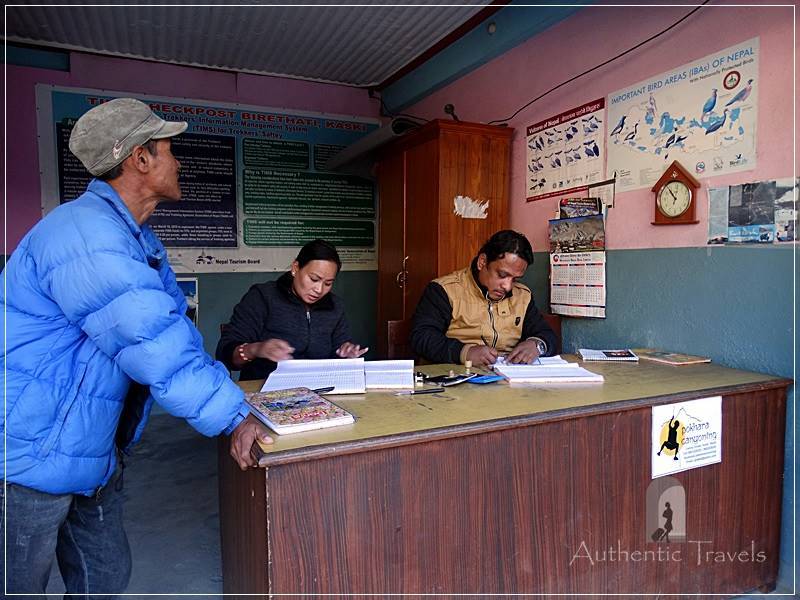
Ghorepani Trek: Birethanti – my guide-porter Salia stamped my permits (tims and national park entrance ticket) at the checkpoint
Birethanti (1025m altitude) was a Gurung village situated at the crossroads of two valleys – the Modi Khola Valley and the Bhurungdi Khola Valley. The village was the departure and arrival point for the Ghorepani Trek as well as for the Annapurna Base Camp Trek. It was also a final point for one of the alternative trails of the Annapurna Circuit. Due to the large flow of tourists during the high season, Birethanti looked impeccably restored and preserved. Along the narrow streets, it featured whitewashed stone houses with blue timber windows and doors, and colorful flowers.
At the main crossroads in Birethanti, we turned left along the Bhurungdi Khola Valley and gently walked uphill on a dirt road. The jeeps left us in a cloud of dust each time they passed up or down the valley. However, the Nepalis still sold bananas, refreshing drinks, and sweets on the side of the dusty road. We gradually passed through Matathanti, Lamdawali, Banjhgara, and Sudame picturesque villages. The villages had carefully cultivated agricultural terraces, varied lodges, and tourist restaurants – modest ones, but with a properly highlighted traditional atmosphere.
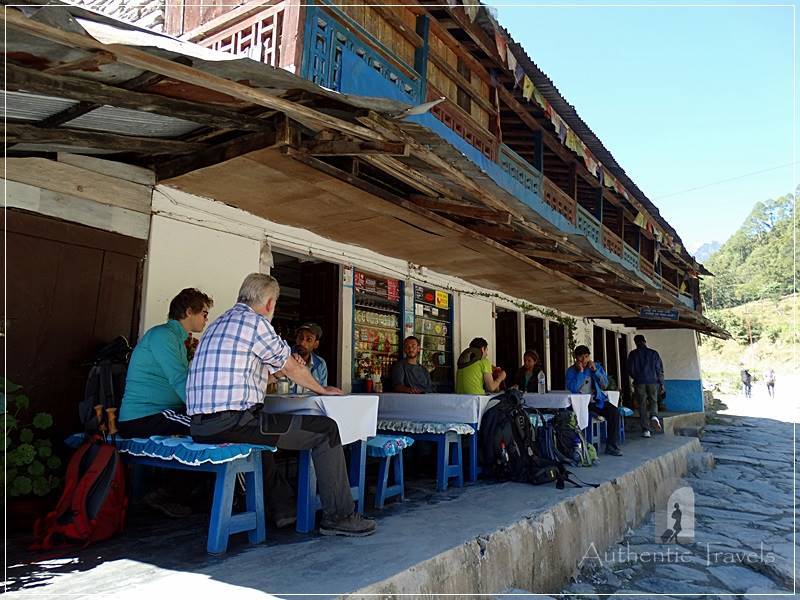
Ghorepani Trek: Lamdawali – almost all houses along the trek were transformed into lodges or/and restaurants
The dirt road along the valley ended in several curves steeply climbing before reaching Hile. There, we stopped to have egg and veggie fried rice for lunch. Hile (1460m altitude) was a small village, but very alive. It had a small square, formed actually as an extension of the trail, and a few lodges gathered around it.
From Hile, we continued the hike and even descended a bit. Then, we started to go up the stone steps climbing endlessly even when we reached Tikhedhungga (1540m altitude). Tikhedhungga was another picturesque village situated at the end of the valley. At the exit from the village, we crossed the Bhurungdi Khola Valley on a suspension bridge and descended abruptly into the valley. After that, we started the hardest ascent of the day – the big stone steps climbing up to Ulleri.
We climbed uneven and very tall stone steps toward Ulleri (2020m altitude) for almost two hours. There, we stayed overnight at Kamala Guesthouse, from where I could see Annapurna South right from my bed.
In the evening, trekkers, porters, and guides gathered in the dining room – the only heated room of the house. I savored a flavored garlic soup, roasted egg cheese, mint tea, and a crispy apple pie. The order for the breakfast should have been made in the evening and the hour for serving it had to be specified, too. I socialized with two girls, one from the Netherlands and one from Spain, until I felt sleepy and went to my room.
Ghorepani Trek, the second trekking day
Short Description: In the morning, I walked a bit through Ulleri. Then, we left the lodge and gradually hiked up toward Banthanti. From there, we continued the trail until we reached a tributary stream of the Bhurungdi Khola Valley. We continued along the valley through Nangge Thanti and Lower Ghorepani and stopped overnight in Upper Ghorepani. In the afternoon, we went to the top of the famous Poon Hill.
Long Description.
In the morning, I woke up having the feeling that I hadn’t slept at all, but surprisingly I was rested. I had breakfast (eggs, cornbread with honey, masala tea, and milk coffee) with Noelia, the Spanish girl from Madrid. She lived in Dublin where she worked in finances. She told me about the women with long necks from Myanmar. Noelia had a Nepalese woman as a guide, whom she had found through the Inside Nepal NGO. She was doing a six-day trek, but she didn’t know many details about the route. She just went with the flow.
After breakfast, I walked a bit through Ulleri – a small village with houses lined up mostly along the trekking route. Most of them were tourist lodges and had roofs, doors, and windows, as well as chairs and tables painted in blue. Most of the tourist lodges faced the terraced valley dominated by Annapurna South. While I was returning to the guesthouse, a line of unloaded mules passed through the village. Before we left Ulleri, Salia called in Ghorepani and booked a single room for me. On the way to Banthanti, we had to climb endless stone steps again. This time, blooming cherry trees flanked the footpath and made it seem less exhausting.
We reached Banthanti (2210m altitude) quite quickly. There, children dressed in uniforms were going to school down in the valley. Some of the houses had dried corncobs or beehives hollowed in trunks hanging under the roofs. A house with the word ‘church’ written on it seemed something strange in a country where Buddhism and Hinduism were the main religions. As we walked on, we noticed a woman washing dishes under a tap with running water located outside the house. Vendors displayed varied items for tourists along the trail.
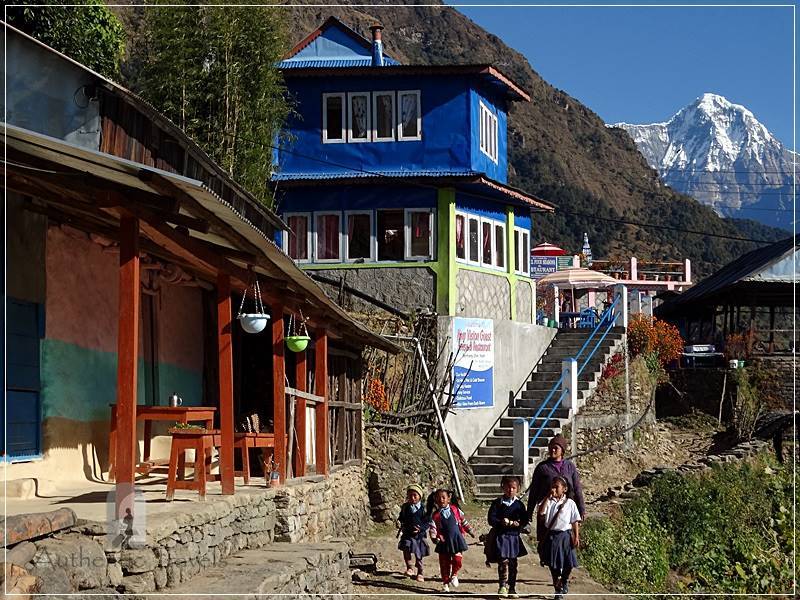
Ghorepani Trek: Banthanti – children going to school in the morning (in the background is Annapurna South Peak)
The footpath went up and down until it reached a tributary stream of the Bhurungdi Khola Valley. After we crossed a small stone bridge, we stopped for a short break, and I filtered water from a nearby stream. Then, we continued the hike along a footpath meandering through the jungle.
We reached Nangge Tahnti (2430m altitude) – a hamlet full of tourist lodges, where a local woman affectionately hugged me and wanted to have a photo with me. From there, the footpath went further through the jungle. By midday, we were already at the checkpoint from Lower Ghorepani.
From Nangge Tahnti we hiked for another ten minutes and arrived in Upper Ghorepani (2860m altitude), where we searched for the Nice View Lodge. From the terrace of the lodge, I saw the famed Dhaulagiri and Annapurna, both over 8000 meters high. In the afternoon, I had a portion of spaghetti with yak cheese and tomato sauce while sitting on the outdoor terrace and looking at the Himalayas.
Usually, trekkers climbed the renowned Poon Hill (3200m altitude) to see the sunrise in the morning. Nevertheless, I preferred to climb it in the afternoon and see the sunset from there. Usually, you had to pay an ‘entrance’ fee when you hiked Poon Hill in the morning, but nobody was there in the afternoon. The whole footpath up to Poon Hill was a succession of stone steps gently climbing up the mountain through a shady tree corridor.
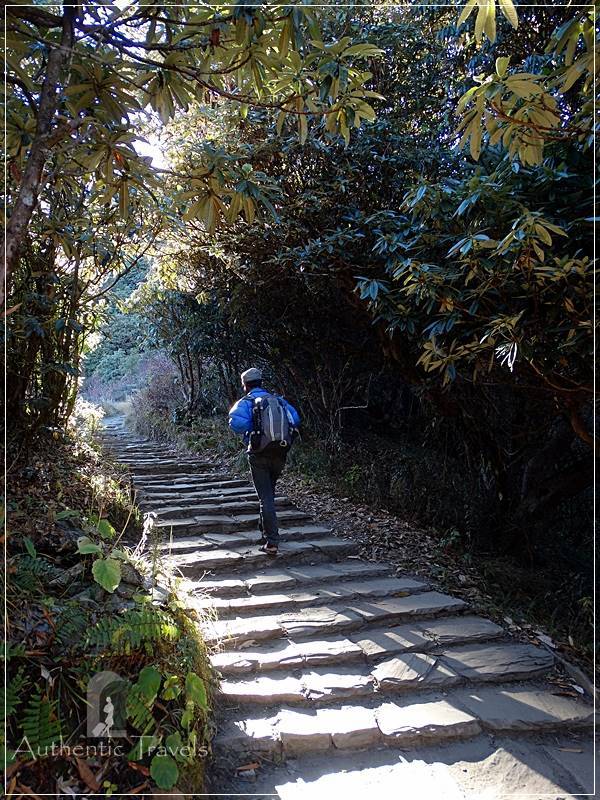
Ghorepani Trek: going up to Poon Hill at sunset (of course, we had stone steps, but not so steep anymore)
The famous lookout on top of Poon Hill had a metallic observatory through which the wind was screaming and blowing powerfully. At sunset, there was a maximum of one hundred trekkers on top of Poon Hill. At sunrise, there were usually between six hundred and one thousand trekkers every day, though. Prayer flags hung and fluttered in the wind everywhere on Poon Hill. Dhaulagiri peak seemed so close that I could have touched it with my hand. I felt the same while looking toward Annapurna peak – it was so close but so far at the same time. I spent a couple of hours taking photos and admiring the view from the top of Poon Hill, and the time flew by very quickly.
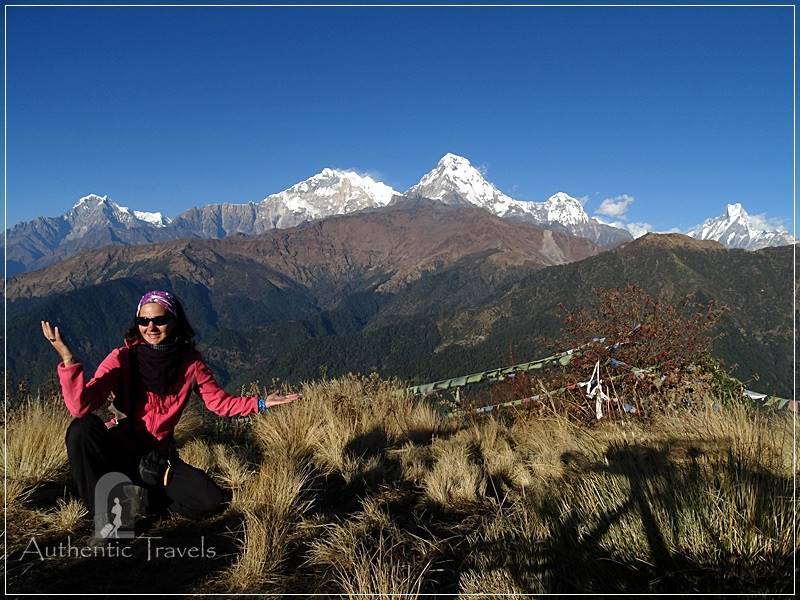
Ghorepani Trek: Poon Hill – views with the Annapurna Himalayan Range (the background peak on the left is Annapurna I – over 8000 m alt.)
When we returned to the guesthouse in Ghorepani, I had another garlic soup, tuna salad with potatoes, apple pie, and mint tea. Satisfied and tired, I went to rest before the following trekking day.
The extended Ghorepani Trek (part I) is the first travelogue about this famous trek in the Annapurna area, Nepal. You can find the version in Romanian at ‘Ghorepani Trek, Aria de Conservare Annapurna, Nepal‘. The continuation of this travelogue can be found at the following link The extended Ghorepani Trek (part II). And here are all the Travelogues from Nepal (x12).
Have you been to Nepal or plan to go there? Leave a comment below this post and tell me what you liked in Nepal or what you want to see there.
Want to subscribe to my travelogues? Just leave your email in the subscription form below, and you’ll be notified when I publish a new post.
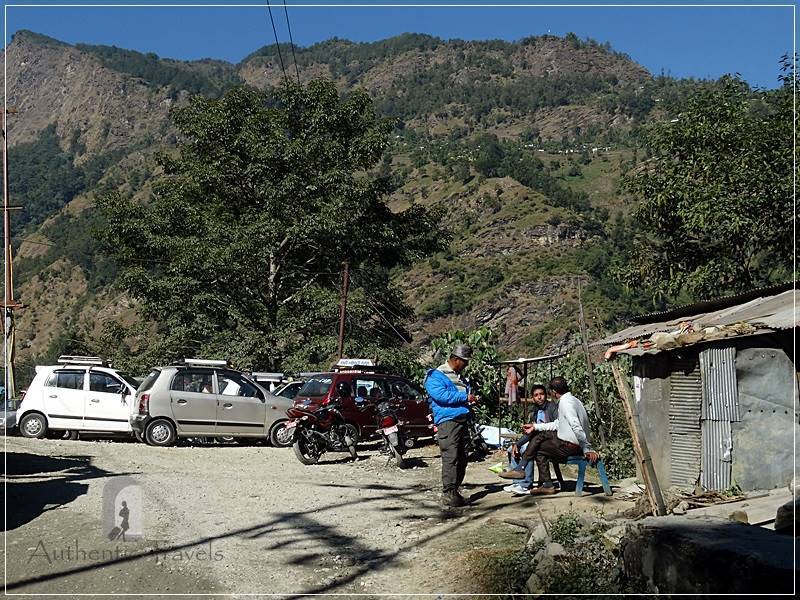
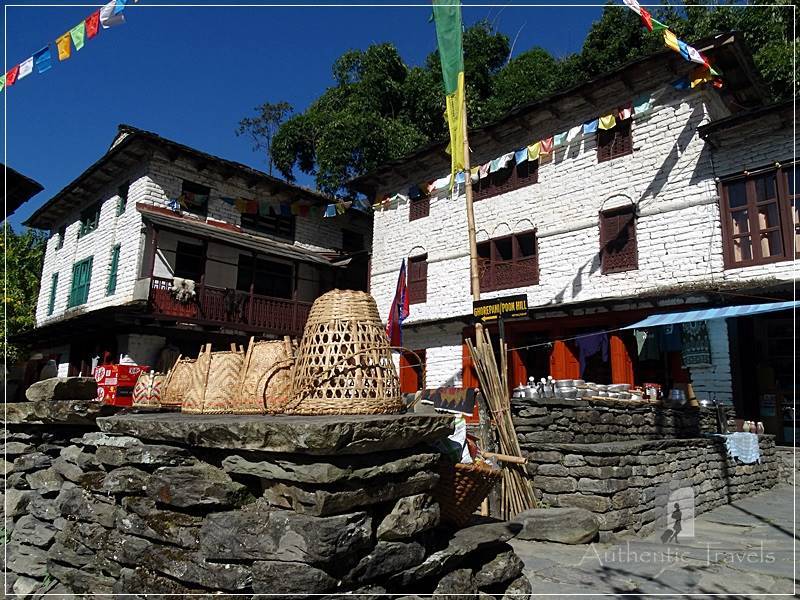
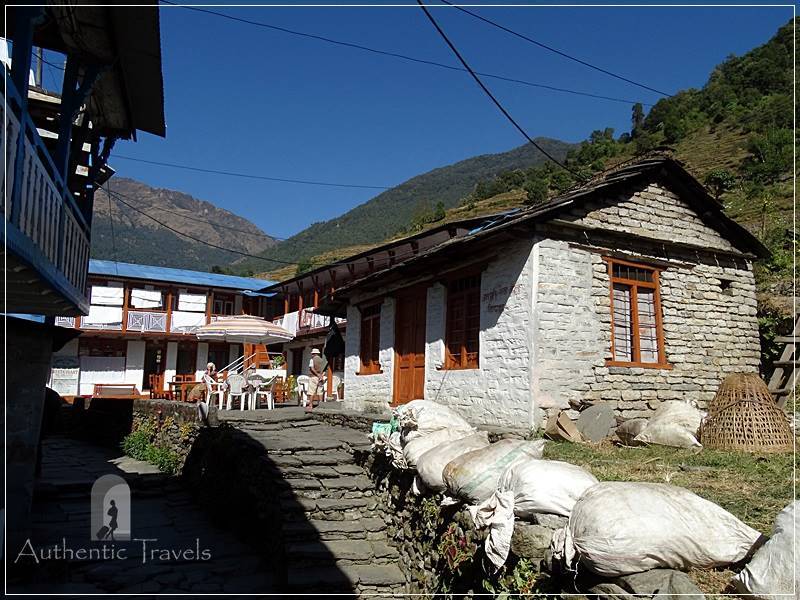
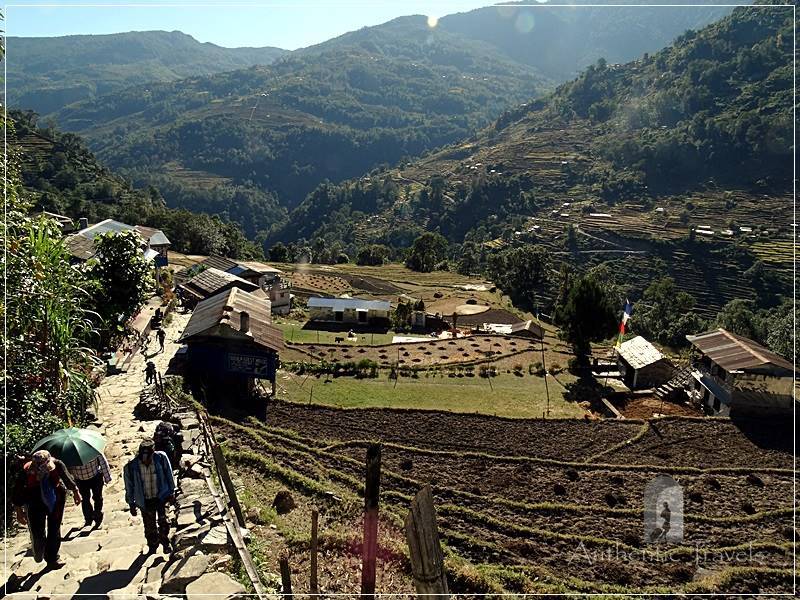
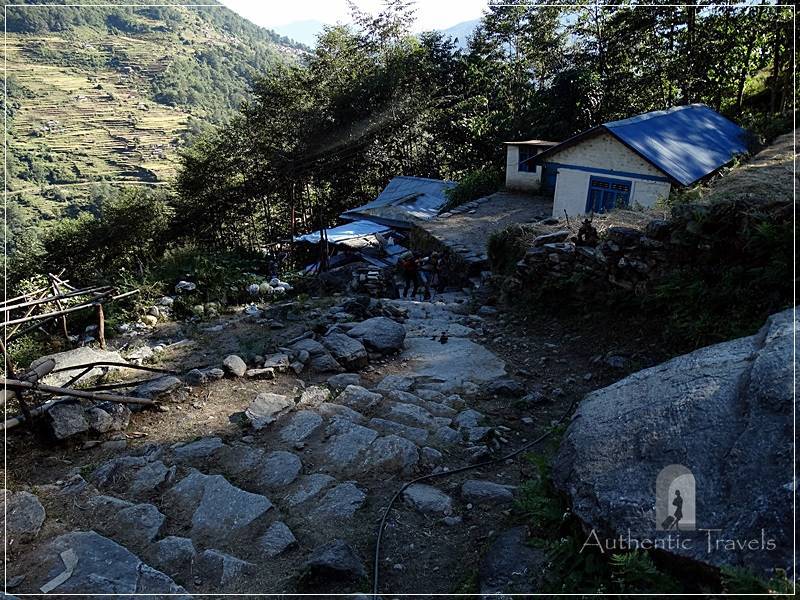
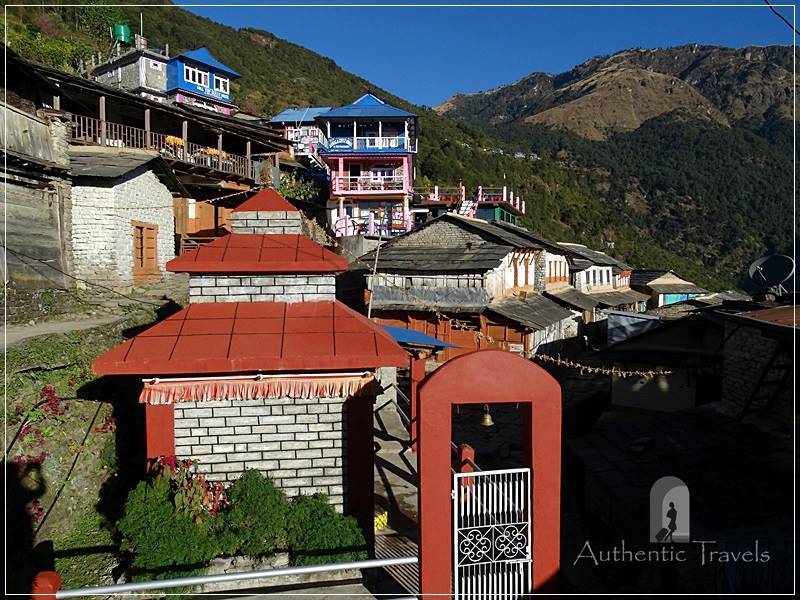

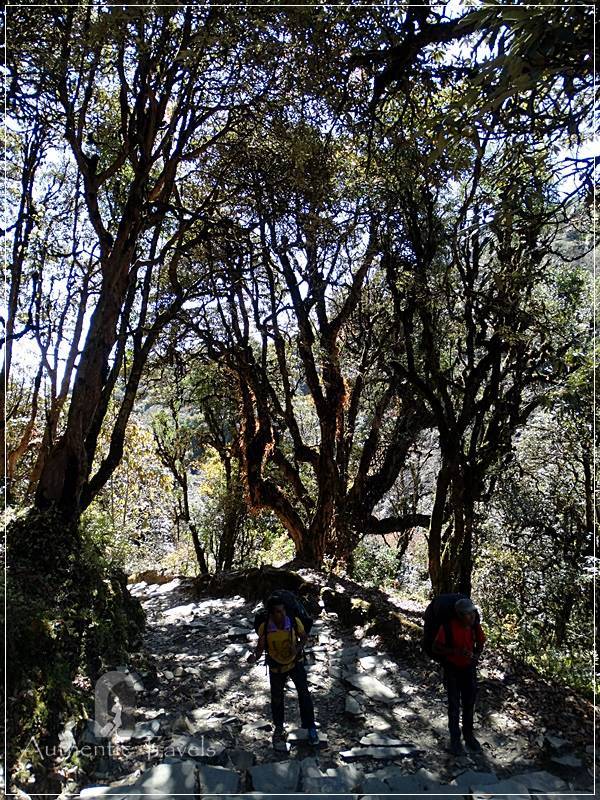
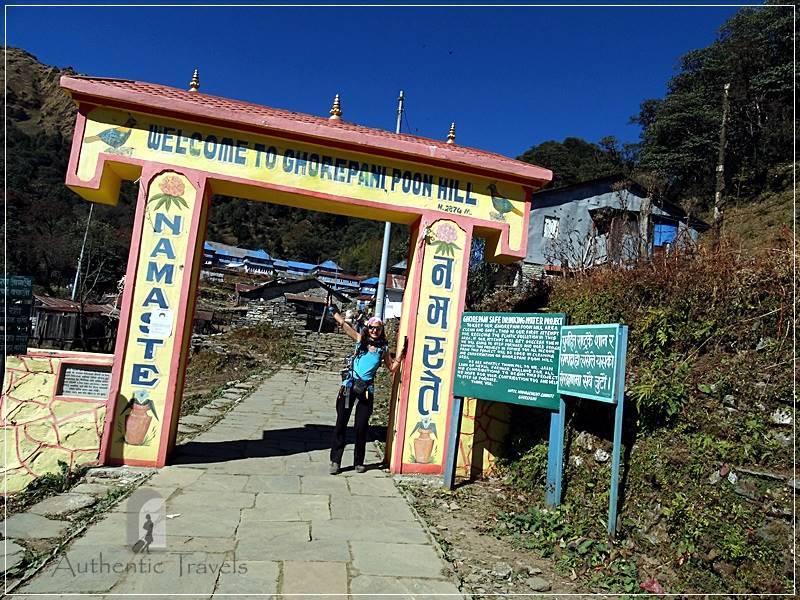
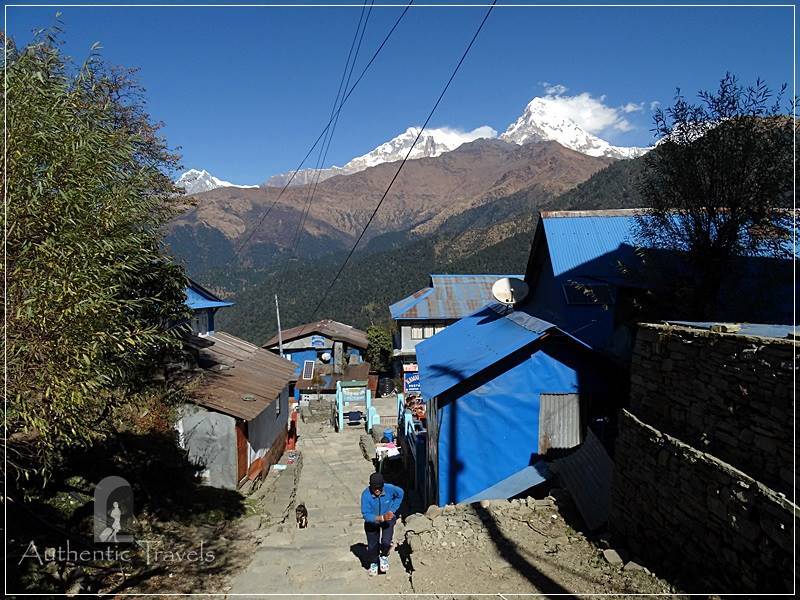
I love that you started with a hearty breakfast – you need one in order to trek, that’s indubitable!
I also love how you provide short and long descriptions – that’s very smart, I must say!
The country of Nepal looks so appealing to me and it’s so sad that there’s a raging corruption and there are people that still live in tents since the earthquake because the government has not allotted the finances to accommodate everybody but, rather, to stuff its closest people.
Thanks for providing us with these awesome photos – they truly speak louder than words 🙂
Thank you very much Dimitrov. My English is not the best as I am not native, so I have to blend images with words.
This sounds amazing and interesting. I love that you describe it in details 😀 It is so important with a big breakfast as well it really makes a difference on your energy. I love the photos and that you captured their life there, it must be such a unique experience. I should trek there right now as I live in Quito, Ecuador and are used to that kind of altitudes ;D
Thank you for this. I gonna pin this for later so I can go back and read this when I visit Nepal 😀
Great. Share with us when you post future treks.